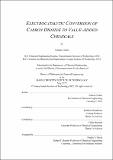Electrocatalytic Conversion of Carbon Dioxide to Value-Added Chemicals
Author(s)
Corbin, Nathan
DownloadThesis PDF (200.6Mb)
Advisor
Manthiram, Karthish
Brushett, Fikile
Terms of use
Metadata
Show full item recordAbstract
Closing the anthropogenic carbon cycle is an urgent issue that faces society. Carbon capture and utilization (CCU) is an attractive strategy because it can help offset the cost and possibly enable profiting off of capturing and storing carbon dioxide (CO2). In this thesis, avenues for electrocatalytically upgrading carbon dioxide are investigated. A comprehensive review on heterogeneous molecular catalysts for aqueous electrocatalytic CO2 reduction was written to synthesize the literature to discern common trends regarding the effects of various aspects of heterogeneous molecular catalysts including the metal center, ligands, axial coordination, electrode grafting, and stability. The review also highlighted key areas where experimental and computational efforts could improve to achieve greater accuracy and comparability of results, including catalyst aggregation, potential referencing, and demetallation. To further expand upon the recommendations of this review, an analysis of various sources of error in electrochemical experiments was conducted to quantitatively assess how different error sources impact mechanistically relevant kinetic parameters (e.g. Tafel slope, order dependence). Simple physical models were constructed to model the errors, which could then be used to provide guidelines on how to properly manage error when performing electrochemical kinetic measurements.
Electrocatalytic carboxylation of organic molecules with CO2 provides another pathway to generate high-value chemicals. We developed a methodology to perform electrocatalytic carboxylation without requiring sacrificial anodes. The key design principle involves adding a salt with an inorganic cation that can suppress nucleophilic side reactions, which lead to lower carboxylic acid yields. This methodology was demonstrated to work for a variety of aliphatic, aryl, and benzylic organic halides. We also discovered an essential protecting mechanism by which the carboxylate product mitigates deactivation of the cathode by insoluble carbonate salts. Hydrogenolysis of the carbon-halide bond represents a major competing electrochemical reaction. The reactive hydrogen for this reaction was found to originate from the electrolyte solvent. Mechanistic studies revealed solvent deprotonation is the primary pathway toward the hydrogenolysis product, and a computational descriptor for solvent deprotonation was found to correlate strongly with carboxylation selectivity.
Date issued
2022-05Department
Massachusetts Institute of Technology. Department of Chemical EngineeringPublisher
Massachusetts Institute of Technology